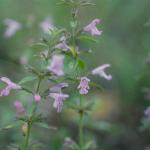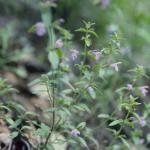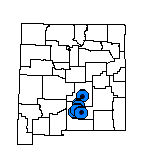Description
Perennial herbs; stems (15)20-30(40) cm tall, few to numerous, ascending or very shortly decumbent, woody below, herbaceous above, branching frequently in lower half, villous below, sparsely to densely puberulent above with tightly retrorse hairs; leaves thick, membranous, elliptical-oblong, 8-18 mm long, 2-6.5 mm wide, margins entire to obscurely serrate, base elongated, petiole short or none, apex obtuse, glabrous above, strigulose below and on margins, nerves conspicuous; cymules well-spaced along upper 2/3 of stems with 3-5(7) flowers per cymule, peduncles 1-2 mm long, pedicels 2-3.5 mm long, minutely puberulent; calyx 6-7 mm long, the tube 3-5 mm long, slightly gibbous below for about 1/2 the tube length, the distended region about 1.2 mm wide, typically moderately hirsute, upper calyx teeth connate for 1/3-1/4 their length, forming an upper lip 1.5-2 mm long, the lobes nearly subulate, about 0.3 mm wide at base, about 1.7 mm long, laterally spreading and reflexed but becoming erect and convergent with lower teeth during maturation, hirsute, lower calyx teeth recurved, subulate, about 0.5 mm wide at base, about 2.7 mm long; corolla, tubular, bilabiate, 10-14 mm long, blue, sparsely villous within the throat and densely short pubescent in the tube forming a well-defined annulus 2-3 mm wide, tube 8-10 mm long, throat strongly dilated, about 5 mm wide, upper lip broadly strap-like, slightly emarginate, 3-3.3 mm wide, 3-4 mm long, straight (not upwardly reflexed), lower lip broad, about 7 mm wide and 5 mm long. Flowers July to September.
Similar Species
Hedeoma pulcherrima is similar to other members of the subgenus Saturejoides, especially H. drummondii, a widespread species, from which H. pulcherrima differs by having a slightly larger corolla, less swollen calyx tube, less convergent calyx teeth, and mostly entire, larger leaves. Hedeoma drummondii has an odor similar to peppermint, whereas H. pulcherrima has no minty odor.
Distribution
New Mexico, Lincoln, and Otero counties, Capitan, White, and Sacramento mountains.
Habitat
Usually on steep hillsides, in rocky and/or disturbed habitats, including roadsides, in montane coniferous forest and piñon-juniper woodland; 1,500-2,350 m (5,000-9,000 ft).
Conservation Considerations
Does not compete well with grasses or encroaching vegetation. The effects of livestock grazing and forest fire on this species have not been studied.
Important Literature
*New Mexico Native Plants Protection Advisory Committee. 1984. A handbook of rare and endemic plants of New Mexico. University of New Mexico Press, Albuquerque.
Irving, R.S. 1980. The systematics of Hedeoma (Labiatae). Sida 8(3):218-295.
Irving, R.S. 1980. Status report, Hedeoma pulcherrimum. For U.S. Fish and Wildlife Service, New Mexico Ecological Services Field Office, Albuquerque.
Wooton, E.O. and P.C. Standley. 1913. Descriptions of new plants preliminary to a report upon the flora of New Mexico. Contributions from the U.S. National Herbarium 16:109-196.





